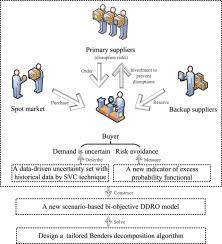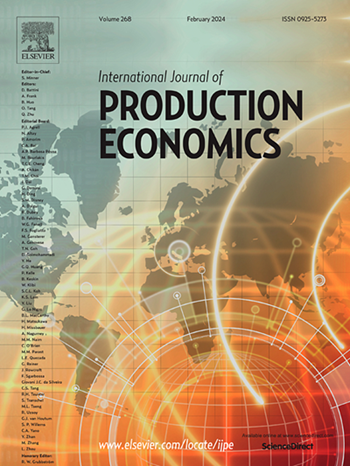Constructing resilient supply chain for risk-averse buyers by data-driven robust optimization approach
IF 10
1区 工程技术
Q1 ENGINEERING, INDUSTRIAL
引用次数: 0
Abstract
Purchasing plays a crucial role in supply chain (SC) management, directly affecting the production and delivery of enterprises. The serious consequences caused by supply disruptions highlight the significance and necessity of preventing disruption. In addition, the economic panic and anxiety caused by disruptions have prompted SC managers to show a preference for risk avoidance. In this paper, based on diversified procurement and disruption prevention strategies, we study the problem of designing a resilient supply chain network (RSCN) that addresses supply disruption risks and uncertain demand for risk-averse buyers. The excess probability functional (EPF) indicator is innovatively customized to accommodate buyers’ risk preferences. Regarding the uncertainty of demand, we utilize the support vector clustering (SVC) technique based on the given historical data to construct a data-driven uncertainty set and employ it to develop a data-driven robust optimization (DDRO) model. By linearization, epsilon-constraint method, and cone optimization theory, our proposed DDRO model can be reformulated as an equivalent tractable mixed integer linear programming (MILP) model and is solved by a new tailored Benders decomposition (BD) algorithm. Experiments under different settings are conducted on a real-world case, and the obtained results verify the validity of our proposed optimization method.

基于数据驱动的稳健优化方法构建风险规避型买方弹性供应链
采购在供应链管理中起着至关重要的作用,直接影响着企业的生产和交付。供应中断造成的严重后果凸显了防止供应中断的重要性和必要性。此外,中断引起的经济恐慌和焦虑促使SC经理表现出规避风险的偏好。本文以多元化采购和中断预防策略为基础,研究了风险厌恶型买家在解决供应中断风险和需求不确定的情况下,如何设计弹性供应链网络的问题。超额概率函数(EPF)指标创新定制,以适应买家的风险偏好。针对需求的不确定性,基于给定的历史数据,利用支持向量聚类(SVC)技术构建数据驱动的不确定性集,并利用该不确定性集构建数据驱动的鲁棒优化(DDRO)模型。通过线性化、ε约束方法和锥优化理论,我们提出的DDRO模型可以重新表述为等效可处理混合整数线性规划(MILP)模型,并通过一种新的定制Benders分解(BD)算法进行求解。在实际情况下进行了不同设置下的实验,得到的结果验证了所提优化方法的有效性。
本文章由计算机程序翻译,如有差异,请以英文原文为准。
求助全文
约1分钟内获得全文
求助全文
来源期刊
CiteScore
21.40
自引率
7.50%
发文量
266
审稿时长
52 days
期刊介绍:
The International Journal of Production Economics focuses on the interface between engineering and management. It covers all aspects of manufacturing and process industries, as well as production in general. The journal is interdisciplinary, considering activities throughout the product life cycle and material flow cycle. It aims to disseminate knowledge for improving industrial practice and strengthening the theoretical base for decision making. The journal serves as a forum for exchanging ideas and presenting new developments in theory and application, combining academic standards with practical value for industrial applications.

 求助内容:
求助内容: 应助结果提醒方式:
应助结果提醒方式:


